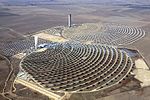- Diffuser (sewage)
-
An air diffuser or membrane diffuser is an aeration device typically in the shape of a disc, tube or plate, which is used to transfer air and with that oxygen into sewage or industrial wastewater. Oxygen is required by microorganisms/bacteria residents in the water to break down the pollutants. Diffusers use either rubber membranes or ceramic elements typically and produce either fine or coarse bubbles.
Contents
Types of Diffusers
Diffusers are generally referred to as either:
Other diffused aeration devices include: jet aerators, aspirators, and U tubes.[1]
Design Specifications
Typical efficiency of a full floor coverage diffused aeration system in clean water is 2%/ft submergence or 6.6%/m submergence. When converted to mass transfer into process or dirty water, it is typically closer to about half of those figures. Manufacturers of fine bubble systems have supported claims that the type, number and size of "pores" have a great effect on efficiency of a diffused aeration system.[2]
Types of diffused aeration systems
Diffusers are typically connected to a piping system which is supplied with pressurized air by a blower. This system is commonly referred to as a diffused aeration system or aeration grid
There are two main types of diffused aeration systems, retrievable and fixed grid, that are designed to serve different purposes. In the case of a plant with a single tank, a retrievable system is desirable, in order to avoid stopping operation of the plant when maintenance is required on the aeration system. Fixed systems, on the other hand, are typically less costly, and often more efficient because it is easier to make full use of the floor.
Automated software is available on the web to assist with drafting of aeration systems in CAD, as well as calculation software to help determine diffuser requirements for a given wastewater.
Developments in Membrane Coatings
A developments in recent years has been surface coatings of PTFE on EPDM membranes. This provides a buffer between the EPDM substrate and wastewater, hence reducing the likelihood of chemical attack and oxidation, and also providing better resistance to biological fouling and calcium scaling (manufacturers claim).[3]
References
- ^ http://www.epa.gov/owm/mtb/fine.pdf
- ^ http://www.wastewater.com/pdf/142.pdf
- ^ http://www.stamfordscientific.com/ptfemembranes.html
External links
- [EDI Tech Bulletins http://www.wastewater.com]
- [SSI Aeration http://www.stamfordscientific.com]
- [Ecosafe diffused aeration http://www.diffusedaeration.com]
Topics related to environmental technology 
Pollution Industrial ecology · Solid waste treatment · Waste management · Air pollution (control · dispersion modeling) · Water (Wastewater treatment · Agricultural wastewater treatment · Industrial wastewater treatment · Sewage treatment · Water purification)Renewable energy Conservation Birth control · Permaculture · Conservation ethic · Recycling · Ecoforestry · Conservation biology · Environmental preservation · Remediation · Green computing · Building (Green · Natural · Sustainable architecture)Categories:- Sewerage
- Water pollution
- Water treatment
- Environmental engineering
- Water technology
- Membrane technology
Wikimedia Foundation. 2010.




